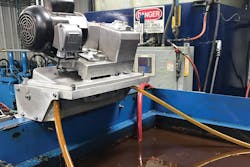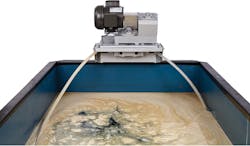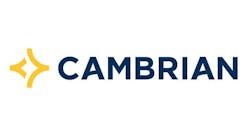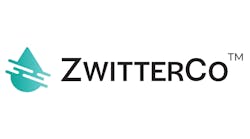FOG removal from wash water and wastewater in industrial facilities
There is a universal challenge throughout the food and beverage industry: fats, oils and grease (FOG) in wash water and wastewater. It is not an isolated problem, but one that affects several segments across the industry, from farm machinery and meat processing to oil transport and cooking.
FOG in water is often unavoidable but has costly effects if left unaddressed. There are solutions for removing FOG from water that can improve wastewater treatment processes, reduce maintenance and downtime and even create an opportunity to sell recovered oil. Common solutions include oil skimmers, oil-water separators or a combination of both. The following will discuss each, but first it is important to identify the source of oil in various segments and understand the importance of removing it.
FOG by industry segments
Fats, oils and grease are common byproducts or ingredients in many segments of the food and beverage industry. Typically, by way of a washdown process, FOG ends up in the wash water and wastewater.
Sources of FOG throughout the food industry include:
Farm equipment: Tractors, seeders, sprayers, combines and other machinery use hydraulic pressure to operate. Lubricants and hydraulic oil end up in wastewater when equipment and facilities are washed down.
Oil extraction: Oils from plants, seeds and nuts coat presses and equipment. During cleaning processes, excess oil appears in wastewater.
Oil transport: Leakage or spillage can occur during tank truck transport of edible oils. Washdown of the area after the transfer can carry oil to the wastewater stream. When cleaning the inside tank trucks, residual oil flows with the wash water into a sump or pit.
Oil used for cooking or as an ingredient: In facilities that use oil to fry foods, or as an ingredient in products like dressings and sauces, equipment and machinery can become coated with oil. Water and oil mix in the washing process, requiring separation and oil removal before the water is discharged.
Fats, oils and grease from meat and fish: FOG is a natural byproduct of processing or cooking meat and fish. From slaughter, grinding or cooking, fat is washed away or drained and combined with water.
Oil from manufacturing containers: Food containers made from paper, plastic, cardboard, metal or glass are manufactured with machines that have many moving parts. Hydraulic oil and lubricants from these machines and manufacturing processes end up in the wastewater stream.
Canning foods and beverages: Can seamers that join the lid to the body of the can require lubrication. The seamer oil eventually finds its way into the facility’s waste stream.
Cooking food for consumption: Restaurants, cafeterias and mess halls use and produce FOG from cooking meals for consumption. Drained during cooking and rinsed during cleaning, fats, oils and grease are funneled to a grease trap where they can build up quickly.
Tube-type oil skimmer with a free-floating collector tube removes FOG from a tank.
FOG in water
FOG may exist in all types of facilities, but the question is: Why does it matter and how can it be detrimental to business?
Oily water increases costs to treat the water. Oil and grease in the wastewater blinds filters, coats pH and temperature probes and may require the use of additional chemicals — all of which increase maintenance costs — which makes treatment more challenging, expensive and time consuming.
FOG in water increases the cost of water discharge. When oil and grease quantities in wastewater exceed local water treatment authority limits, discharge costs increase. A surcharge or fine may be added to the normal discharge fee in addition to extra fees for inspection and testing if the treatment plant requires.
When separated and removed properly from wastewater, FOG can be sold to companies that refine or repurpose it. So, efficient separation turns FOG into a potential revenue source.
Solutions
Choosing the right oil-removal solution depends on many circumstances of the application, but one key factor to note is oil flotation. If oil is able to separate and rise to the surface of the water, an oil skimmer can be installed to continuously remove the oil. If the oil is mechanically emulsified, or entrained in the water, and requires more time and/or space to rise to the surface, an oil-water separator may be the most practical solution to help accelerate the separation of oil from water.
Oil skimmers
Oil skimming is the process of removing floating oil from the surface of water. Oil skimmers are commonly installed on tanks, sumps or existing oil-water separators where oil is freely floating on the surface of the water.
Oil skimmers commonly feature an oleophilic (oil-loving) element that is introduced into the oily water. Oil adheres to the skimming element — for example, an oil skimming free-floating collector tube — and then is scraped off by the skimmer and collected. Alternatively, a weir-type skimmer works by allowing oil to overflow into it, similar to using a spoon during cooking to remove the grease from the pot.
Advantages of using an oil skimmer to remove FOG from water before the water is filtered, treated, cooled or discharged include:
• Improving efficiency of wastewater treatment processes, resulting in cleaner wastewater and lower operational costs.
• Eliminating or reduces the need for water treatment chemicals.
• Preventing bacteria growth and foul odors and decreases the amount of sludge produced since the surface is skimmed and FOG buildup is prevented.
• Creating new revenue opportunities through the recovery of used oil that can be sold for a profit.
• Reducing maintenance and costly downtime by keeping treatment equipment free from oil, clogs, coated sensors and blinded filters.
Tube-type oil skimmers
A tube-type oil skimmer uses a closed-loop, free-floating collector tube that operates on the surface of the water, attracting the floating oil or grease. Oil adheres to the outside of the collector tube, as it is continuously driven across the water’s surface and through the skimmer where scrapers remove the oil. One notable advantage of a tube skimmer is that the tube floats freely on the surface, unaffected by debris that otherwise prevents oil from reaching other types of skimmers that follow a fixed path.
For example, one heavy equipment rental business relies on a tube-type oil skimmer to keep hundreds of gallons of FOG from reaching the local sewer each month. When machines are returned to their facility, they are often loaded with mud, grease and oil.
After washing the vehicles, oily wash water flows into a tank or sump where a tube skimmer is installed. Each month, 465 gallons of recyclable oil is recovered by the skimmer, keeping it from reaching the local sewer system.
Oil-water separators
Fats, oils and grease have a lower specific gravity (weight) than water. That is the reason why, when given the opportunity (such as time and nonturbulent conditions), the lighter oil will naturally separate from heavier water, rise and float on the water’s surface. An oil-water separator is a device designed to provide this opportunity.
Separators come in many styles and sizes — some with baffles and coalescing media to regulate the water flow and promote oil separation using less physical space. Many variables dictate the type and size of separator needed, including the flow rate of the oily water mix, as well as its temperature and volume, the density (specific gravity) of the oil and the presence of solids.
As oil rises and floats on the surface of water, it is advantageous to remove the oil continuously to minimize maintenance and keep the separator operating at optimal efficiency.
When oil is not removed on a continuous basis from the surface of the water in an oil-water separator, a number of issues can arise, including:
• Visual inspection and ongoing maintenance of the separator and its components can be difficult, if not impossible, to conduct.
• A surge in flow rate can exceed the capacity of the separator and wash out the oil buildup, allowing oil to escape with the effluent.
• Oxygen is prevented from reaching the water, allowing anaerobic bacteria to grow, which can cause health concerns, emit foul odors and drive up the maintenance challenges of eliminating these conditions.
Separate and skim
While traditional oil-water separators are capable of separating oil from water if designed and sized properly, they often do not provide an optimal solution for continuously removing the oil following separation. A Separate and Skim (SAS) Tank is an oil-water separator with an integrated tube-type oil skimmer for continuous oil removal. This feature keeps the separator operating most efficiently and prevents buildup of oil on the surface of the water, which is the primary cause of bacteria growth, odors and maintenance headaches in traditional oil-water separators.
Application: Food packaging manufacturer
A manufacturer of corrugated cartons routinely cleans the plant’s floor. The wash water mixes with residual lubricant and hydraulic oil, preventing the plant from being able to discharge the wastewater down the drain.
The plant did not have a suitable solution to allow for separation and removal of the oil from the wash water. Instead, the plant paid a premium rate to have the oily wash water hauled away and treated. The installation of a SAS Tank provided a solution for both separation and skimming. This eliminated the cost of a third-party contractor and enabled the manufacturer to safely discharge its wastewater into the local sanitary sewer.
Guy Flynn is the director of marketing at Oil Skimmers, Inc. Flynn has authored several articles, white papers and e-books for those facing the common challenges of oil-and-water applications. Oil Skimmers, Inc. — a manufacturer of oil skimmers, oil removal systems and oil-water separators, specializing in separating and recovering all types of floating waste oils, greases and fats from water — is headquartered in Cleveland, Ohio, with factory-trained representatives across the U.S. and around the world. For more information, contact Flynn at 440-237-4600 or at [email protected].



